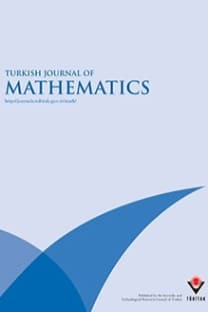Second order approximations in sequential point estimation of the probability of zero in Poisson distribution
Poisson distribution, regret, second-order approximations, sequential estimation
Second order approximations in sequential point estimation of the probability of zero in Poisson distribution
___
- Ali, M., Isogai, E.: Sequential point estimation of the powers of an exponential scale parameter. Scientiae Mathematicae Japonicae 58, 39–53 (2003).
- Aras, G., Woodroofe, M.: Asymptotic expansions for the moments of a randomly stopped average. The Annals of Statistics 21, 503–519 (1993).
- Cameron, A.C., Trivedi, P. K.: Essentials of count data regression, A Companion to Theoretical Econometrics. Oxford. Blackwell 2001.
- Chatfield, C.: Statistics for Technology, 3nd ed. London. Chapman Hall 1983.
- Chow, Y.S., Hsiung, C.A., Lai, T.L.: Extended renewal theory and moment convergence in Anscombes theorem. The Annals of Probability 7, 304–318 (1979).
- Feller, W.: An Introduction to Probability Theory and Its Applications, 3nd ed., vol. 1. New York. Wiley 19 Ghosh M., Mukhopadhyay, N.: Sequential estimation of the percentiles of exponential and normal distributions. The South Africa Statistics Journal 23, 117–136 (1989).
- Greig-Smith, P.: Quantitative Plant Ecology, 2nd ed. London. Butterworth 1964.
- Handle, J.B.S.: On a method of estimating frequencies. Biometrika 33, 222–225 (1945).
- Johnson, N.L., Kotz, S., Kemp, A.W.: Univariate discrete distributions, 2nd ed. New York. John Wiley 1992. Lee, A.H., Wang, K., Yau, K.K.W.: Analysis of zero inflated Poisson data incorporating extent of exposure. Biometrical Journal 43, 963–975 (2001).
- Mukhopadhyay, N., Padmanabhan, A.R., Solanky, T.K.S.: On estimating the reliability after sequentially estimating the mean: the exponential case. Metrika 45, 235–252 (1997).
- Poisson, S.D.: Recherches sur la probabilite des Jugements en Matiere Criminelle et en Matiere Civile, Precedees des Regles. Generales du calcul des Probabilities, Paris: Bachelier,Imprimeur Libraire pour les mathematiques, la physique, etc., 1837.
- Starr, N., Woodroofe, M.: Further remarks on sequential estimation. The Annals of Mathematics Statistics 43, 1147–1154 (1972).
- Stein, C.: A two sample test for a linear hypothesis whose power is independent of the variance. Ann. Math. Statist. 16, 243–258 (1945).
- Takada, Y.: Non-existence of fixed sample size procedures for scale families. Sequential Analysis 5, 93–100 (1986).
- Takada, Y.: Fixed-width confidence intervals for a function of normal parameters. Sequential Analysis 16, 107–117 (1997).
- Uno C., Isogai, E.: Sequential point estimation of the powers of a normal scale parameter. Metrika 55, 215–232 (2002).
- Uno, C., Isogai, E., Lou Lim, D.: Sequential point estimation of a function of the exponential scale parameter. Austrian Journal of Statistics 33(3), 281–291 (2004). van der Waerden, B.L.: Sampling inspection as a minimum loss problem. Annals of Mathematical Statistics 31, 369–384 (1960).
- Wald, A.: Sequential tests of statistical hypothesis. Annals of Mathematical Statistics 16, 117–186 (1945).
- Walsh, J.E.: The Poisson distribution as a limit for dependent binomial events with unequal probabilities. Operations Research 3, 198–209 (1955).
- Woodroofe, M.: Second order approximations for sequential point and interval estimation. The Annals of Statistics 5, 984–995 (1977).
- Yau, K.K.W., Wang, K., Lee, A.H.: Zero-inflated negative binomial mixed regression modeling of overdispersed count data with extra zeros. Biometrical Journal 45, 437–452 (2003).
- ISSN: 1300-0098
- Yayın Aralığı: 6
- Yayıncı: TÜBİTAK
Complex symplectic geometry with applications to vector differential operators
Lp solutions of infinite time interval BSDEs and the corresponding g-expectations and g-martingales
Eisa MAHMOUDI, Mohammad Hatami KAMIN
On the nilpotent graph of a ring
Soheila KHOJASTEH, Mohammad Javad NIKMEHR
BBM equation with non-constant coefficients
Finite rings and Wilson's theorem
Yasuyuki HIRANO, Manabu MATSUOKA
Generalized Sobolev-Shubin spaces, boundedness and Schatten class properties of Toeplitz operators
Ahmet Turan GÜRKANLI, Ayşe SANDIKÇI
On theta pair for a proper subalgebra
Hamid MOHAMMADZADEH, Ali Reza SALEMKAR, Sara CHEHRAZI
